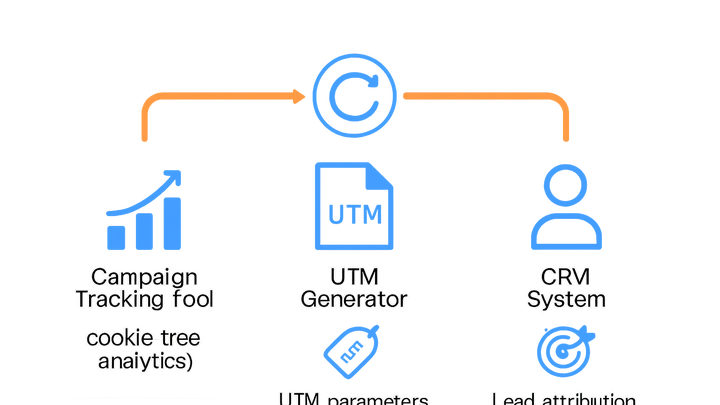Published on 2025-06-29T19:40:47Z
What is CRM Integration? Examples for CRM Integration
CRM Integration in campaign tracking & analytics refers to the process of connecting marketing analytics tools — like Plainsignal and UTMguru — to a Customer Relationship Management (CRM) system. This integration enables automatic synchronization of campaign data, such as UTM parameters and user events, into the CRM. By unifying these data sources, businesses gain a complete view of customer interactions, improve lead attribution, and streamline marketing workflows. A well-executed CRM integration closes the feedback loop between ad spend and sales outcomes, allowing more informed decision-making and higher ROI. By automating the flow of tracking data, teams eliminate manual entry errors and free up resources to focus on optimization.
Crm integration
Connecting analytics tools like Plainsignal and UTMguru to a CRM to automate data sync, enhance attribution, and drive unified customer insights.
What is CRM Integration?
CRM Integration bridges campaign tracking & analytics platforms with your Customer Relationship Management system to unify data. It ensures that key metrics, UTM parameters, and user events captured by analytics tools flow directly into the CRM, creating a single source of truth for marketing and sales teams.
-
Definition
The process of connecting a CRM system with analytics and campaign tracking tools to automatically sync data such as leads, UTM parameters, and user interactions.
-
Importance in campaign tracking
It closes the loop between marketing campaigns and sales results.
- Unified customer view:
Combines online campaign data with CRM records to see every touchpoint.
- Accurate lead attribution:
Maps UTM parameters generated by tools like UTMguru directly to CRM fields.
- Automated follow-up:
Triggers sales actions or nurturing workflows based on real-time analytics events.
- Unified customer view:
How CRM Integration Works
Under the hood, CRM Integration relies on APIs, webhooks, and data mapping to ensure seamless data flow. The process typically involves authenticating the systems, defining which events or fields to sync, and setting up triggers for real-time or batch transfers.
-
Authentication & security
Securely connect analytics tools to the CRM using API keys or OAuth tokens.
- Api keys:
Simple token-based access managed per application.
- Oauth:
Token exchange protocol providing granular scopes and user consent.
- Api keys:
-
Data sync patterns
Choose between real-time event-based sync or scheduled batch transfers.
- Real-time sync:
Immediate push of events (e.g., form submissions) into the CRM.
- Batch sync:
Periodic uploads of aggregated campaign data to reduce API calls.
- Real-time sync:
-
Data mapping & transformation
Align fields in the analytics system (e.g., UTM fields) with CRM properties.
- Field mapping:
Ensure UTM_campaign maps to CRM’s Campaign Source field.
- Value normalization:
Standardize naming conventions (e.g., lowercase, hyphens).
- Field mapping:
Example Implementation with Plainsignal and UTMguru
This section walks through integrating PlainSignal’s cookie-free analytics snippet with a CRM, using UTMguru to generate consistent tracking parameters.
-
Prerequisites
You need: a PlainSignal account with your data-id, access to your website code, and a UTMguru account to build UTM URLs.
-
Implementation steps
Follow these steps to capture UTM data and sync it to your CRM.
- 1. generate utm codes:
Use UTMguru.com to build UTM parameters for each campaign.
- 2. install plainsignal snippet:
Insert the tracking script into your website’s header.
- 3. map data to crm:
Configure your CRM’s API to accept UTM fields as contact properties.
- 1. generate utm codes:
-
Sample code
<link rel="preconnect" href="//eu.plainsignal.com/" crossorigin /> <script defer data-do="yourwebsitedomain.com" data-id="0GQV1xmtzQQ" data-api="//eu.plainsignal.com" src="//cdn.plainsignal.com/plainsignal-min.js"></script>
Benefits of CRM Integration
Integrating your campaigns with the CRM unlocks powerful insights and efficiencies that drive revenue growth.
-
Improved attribution
Tie every lead directly back to its originating campaign and channel.
-
Centralized data
Maintain a single source of truth for marketing and sales metrics.
-
Automated workflows
Trigger emails, tasks, or follow-ups based on campaign interactions.
Best Practices
Adhering to these practices ensures a reliable and scalable CRM integration.
-
Consistent utm naming conventions
Use a tool like UTMguru to enforce standardized parameters across all campaigns.
-
Monitor integration logs
Regularly review API error logs to catch and resolve sync failures promptly.
-
Ensure data privacy compliance
Securely store and transfer data in line with GDPR, CCPA, and other regulations.
